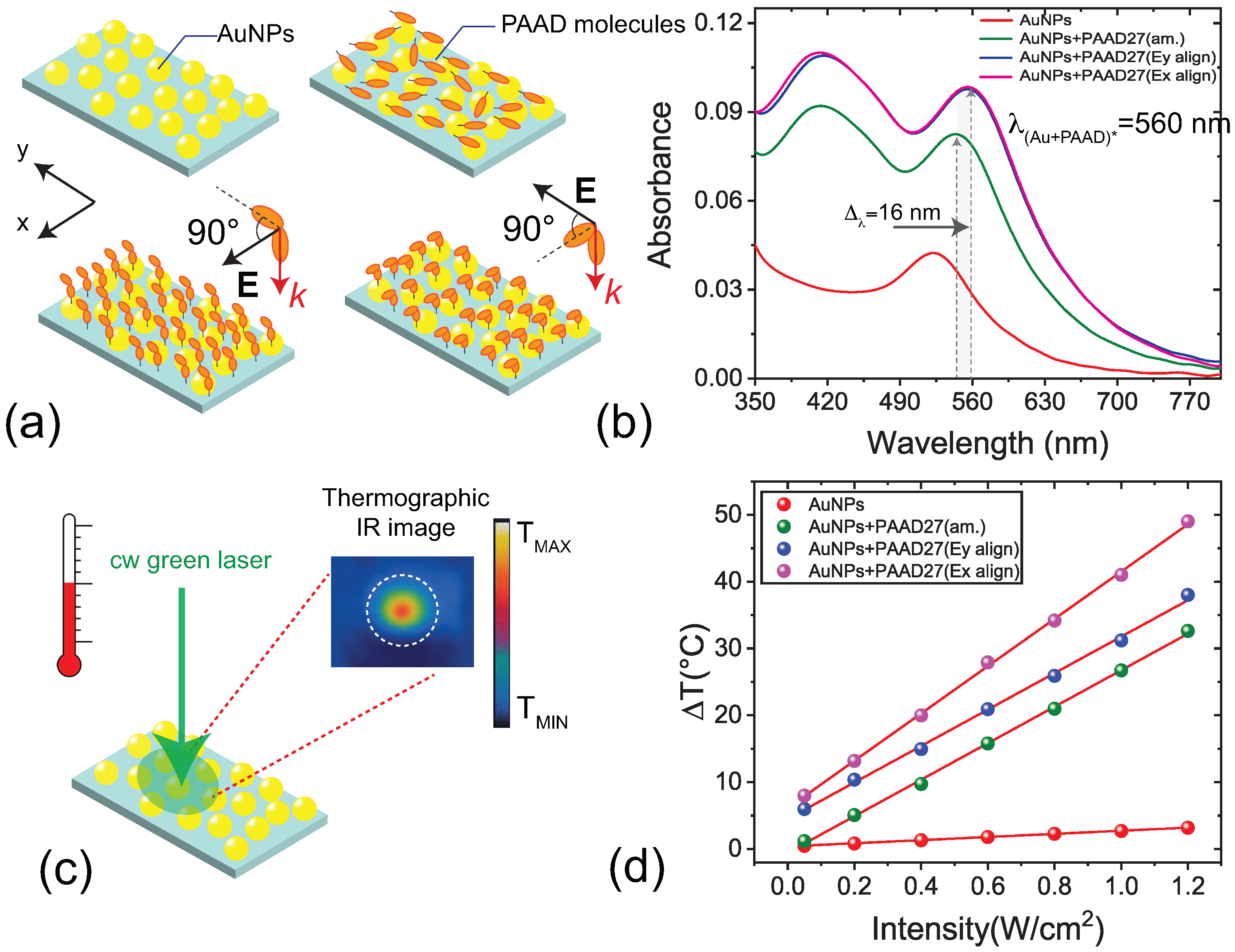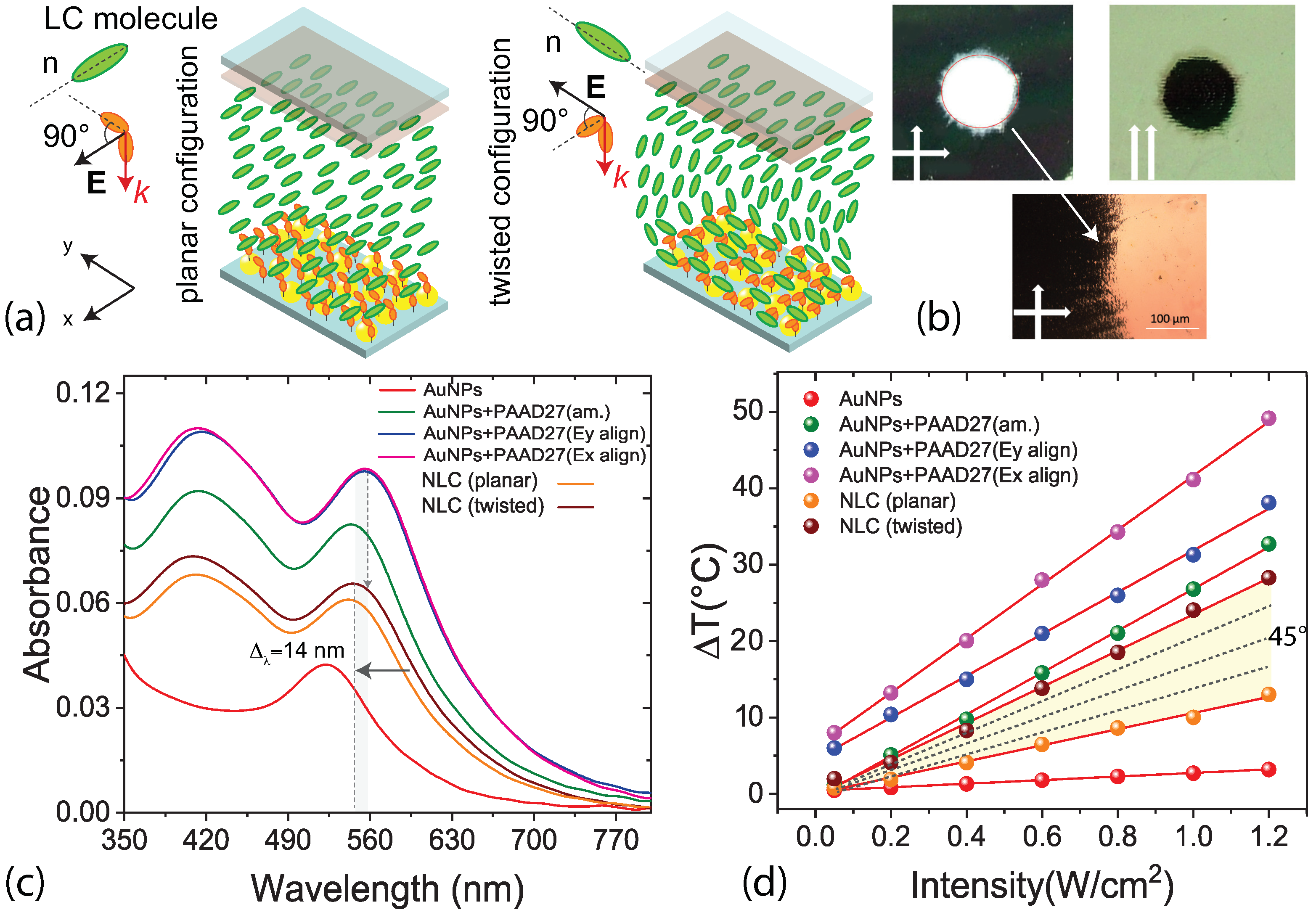Photo-Aligned Nematic Liquid Crystals Enable the Modulation of Thermoplasmonic Heating
Abstract
:1. Introduction
2. Materials and Methods
3. Results and Discussion
4. Conclusions
Author Contributions
Funding
Institutional Review Board Statement
Informed Consent Statement
Data Availability Statement
Acknowledgments
Conflicts of Interest
References
- Baffou, G.; Quidant, R. Thermo-plasmonics: Using metallic nanostructures as nano-sources of heat. Laser Photonics Rev. 2013, 7, 171–187. [Google Scholar] [CrossRef]
- Baffou, G.; Quidant, R. Thermoplasmonics. In World Scientific Handbook of Metamaterials and Plasmonics: Volume 4: Recent Progress in the Field of Nanoplasmonics; World Scientific: Singapore, 2018; pp. 379–407. [Google Scholar]
- Baffou, G.; Cichos, F.; Quidant, R. Applications and challenges of thermoplasmonics. Nat. Mater. 2020, 19, 946–958. [Google Scholar] [CrossRef] [PubMed]
- Govorov, A.O.; Richardson, H.H. Generating heat with metal nanoparticles. Nano Today 2007, 2, 30–38. [Google Scholar] [CrossRef]
- Lal, S.; Clare, S.E.; Halas, N.J. Nanoshell-enabled photothermal cancer therapy: Impending clinical impact. Acc. Chem. Res. 2008, 41, 1842–1851. [Google Scholar] [CrossRef] [PubMed]
- Huang, X.; Jain, P.K.; El-Sayed, I.H.; El-Sayed, M.A. Plasmonic photothermal therapy (PPTT) using gold nanoparticles. Lasers Med. Sci. 2008, 23, 217–228. [Google Scholar] [CrossRef]
- Guglielmelli, A.; Rosa, P.; Contardi, M.; Prato, M.; Mangino, G.; Miglietta, S.; Petrozza, V.; Pani, R.; Calogero, A.; Athanassiou, A.; et al. Biomimetic keratin gold nanoparticle-mediated in vitro photothermal therapy on glioblastoma multiforme. Nanomedicine 2020, 16, 121–138. [Google Scholar] [CrossRef]
- Tordera, D.; Zhao, D.; Volkov, A.V.; Crispin, X.; Jonsson, M.P. Thermoplasmonic semitransparent nanohole electrodes. Nano Lett. 2017, 17, 3145–3151. [Google Scholar] [CrossRef]
- Agarwal, D. Engineering Phonon, Photon, Electron and Plasmon Interactions in Silicon-Metal Nanocavitiies for Silicon Photonics and Thermoplasmonics. Ph.D. Thesis, University of Pennsylvania, Philadelphia, PA, USA, 2016. [Google Scholar]
- Wang, S.; Komvopoulos, K. Effect of material optical properties on thermo-plasmonics of heat-assisted magnetic recording devices. J. Appl. Phys. 2018, 124, 185109. [Google Scholar] [CrossRef]
- Pierini, F.; Guglielmelli, A.; Urbanek, O.; Nakielski, P.; Pezzi, L.; Buda, R.; Lanzi, M.; Kowalewski, T.A.; De Sio, L. Thermoplasmonic-Activated Hydrogel Based Dynamic Light Attenuator. Adv. Opt. Mater. 2020, 8, 2000324. [Google Scholar] [CrossRef]
- Lio, G.E.; Ferraro, A.; Ritacco, T.; Aceti, D.M.; De Luca, A.; Giocondo, M.; Caputo, R. Leveraging on ENZ Metamaterials to Achieve 2D and 3D Hyper-Resolution in Two-Photon Direct Laser Writing. Adv. Mater. 2021, 33, 2008644. [Google Scholar] [CrossRef]
- Cunha, J.; Guo, T.L.; Koya, A.N.; Toma, A.; Prato, M.; Della Valle, G.; Alabastri, A.; Proietti Zaccaria, R. Photoinduced Temperature Gradients in Sub-Wavelength Plasmonic Structures: The Thermoplasmonics of Nanocones. Adv. Opt. Mater. 2020, 8, 2000568. [Google Scholar] [CrossRef]
- Zhu, M.; Baffou, G.; Meyerbrker, N.; Polleux, J. Micropatterning thermoplasmonic gold nanoarrays to manipulate cell adhesion. ACS Nano 2012, 6, 7227–7233. [Google Scholar] [CrossRef] [Green Version]
- Shen, W.; Black, N.; Kalies, S.; Mazur, E. Impulse generated by laser-irradiated nanostructures in water and its effects on cell poration. Plasmon. Biol. Med. Int. Soc. Opt. Photonics 2021, 11661, 116610C. [Google Scholar]
- Naldoni, A.; Kudyshev, Z.A.; Mascaretti, L.; Sarmah, S.P.; Rej, S.; Froning, J.P.; Tomanec, O.; Yoo, J.E.; Wang, D.; Kment, S.; et al. Solar thermoplasmonic nanofurnace for high-temperature heterogeneous catalysis. Nano Lett. 2020, 20, 3663–3672. [Google Scholar] [CrossRef]
- Chehadi, Z.; Girardon, J.S.; Capron, M.; Dumeignil, F.; Jradi, S. Thermoplasmonic-induced energy-efficient catalytic oxidation of glycerol over gold supported catalysts using visible light at ambient temperature. Appl. Catal. A Gen. 2019, 572, 9–14. [Google Scholar] [CrossRef]
- Pezzi, L.; Palermo, G.; Veltri, A.; Cataldi, U.; Bürgi, T.; Ritacco, T.; Giocondo, M.; Umeton, C.; De Luca, A. Photo-thermal study of a layer of randomly distributed gold nanoparticles: From nano-localization to macro-scale effects. J. Phys. D Appl. Phys. 2017, 50, 435302. [Google Scholar] [CrossRef] [Green Version]
- Saupe, A. On molecular structure and physical properties of thermotropic liquid crystals. Mol. Cryst. Liq. Cryst. 1969, 7, 59–74. [Google Scholar] [CrossRef]
- Khoo, I.C. Liquid Crystals; John Wiley & Sons: Hoboken, NJ, USA, 2007; Volume 64. [Google Scholar]
- de Gennes, P.; Prost, J. The Physics of Liquid Crystals; Oxford University Press: Oxford, UK, 1993; Volume 83. [Google Scholar]
- Khoo, I.C. Nonlinear optics, active plasmonics and metamaterials with liquid crystals. Prog. Quantum Electron. 2014, 38, 77–117. [Google Scholar] [CrossRef]
- Si, G.; Zhao, Y.; Leong, E.S.P.; Liu, Y.J. Liquid-crystal-enabled active plasmonics: A review. Materials 2014, 7, 1296–1317. [Google Scholar] [CrossRef] [PubMed]
- Palermo, G.; Sio, L.D.; Placido, T.; Comparelli, R.; Curri, M.L.; Bartolino, R.; Umeton, C. Plasmonic thermometer based on thermotropic liquid crystals. Mol. Cryst. Liq. Cryst. 2015, 614, 93–99. [Google Scholar] [CrossRef]
- Kimling, J.; Maier, M.; Okenve, B.; Kotaidis, V.; Ballot, H.; Plech, A. Turkevich method for gold nanoparticle synthesis revisited. J. Phys. Chem. B 2006, 110, 15700–15707. [Google Scholar] [CrossRef] [PubMed]
- Perivolari, E.; D’Alessandro, G.; Apostolopoulos, V.; Brouckaert, N.; Heiser, T.; Kaczmarek, M. Two-dimensional snapshot measurement of surface variation of anchoring in liquid crystal cells. Taylor Francis Liq. Cryst. 2021, 1, 1–11. [Google Scholar]
- Stöhr, J.; Samant, M.G.; Cossy-Favre, A.; Diaz, J.; Momoi, Y.; Odahara, S.; Nagata, T. Microscopic origin of liquid crystal alignment on rubbed polymer surfaces. ACS Macromol. 1998, 6, 1942–1946. [Google Scholar] [CrossRef]
- Serak, S.V.; Bunning, T.J.; Tabiryan, N.V. Ultrafast photoalignment: Recording a lens in a nanosecond. Crystals 2017, 7, 338. [Google Scholar] [CrossRef] [Green Version]
- Kimball, B.R.; Steeves, D.M.; Hoke, L.; Osgood, R.M.; Carlson, J.; Belton, L.; Tabiryan, N.V.; Rersisyan, S.R.; Serak, S.V.; Hrozhyk, U.A.; et al. Advances in Anisotropic Materials for Optical Switching; Technical Report; Massachusetts Inst of Tech Lexington Lincoln Lab: Lexington, MA, USA, 2010. [Google Scholar]
- Grillo, R.; Beutel, D.; Cataldi, U.; Rockstuhl, C.; Bürgi, T. Self-Assembled Arrays of Gold Nanorod-Decorated Dielectric Microspheres with a Magnetic Dipole Response in the Visible Range for Perfect Lensing and Cloaking Applications. ACS Appl. Nano Mater. 2020, 3, 6108–6117. [Google Scholar] [CrossRef]
- Fu, Q.; Sun, W. Mie theory for light scattering by a spherical particle in an absorbing medium. Appl. Opt. 2001, 40, 1354–1361. [Google Scholar] [CrossRef] [PubMed]
- Pezzi, L.; De Sio, L.; Veltri, A.; Placido, T.; Palermo, G.; Comparelli, R.; Curri, M.L.; Agostiano, A.; Tabiryan, N.; Umeton, C. Photo-thermal effects in gold nanoparticles dispersed in thermotropic nematic liquid crystals. Phys. Chem. Chem. Phys. 2015, 17, 20281–20287. [Google Scholar] [CrossRef] [PubMed] [Green Version]



| Sample | : Sensitivity (/) [°C m2/W] | |
|---|---|---|
| AuNPs | 3.2 ± 0.3 | 2.35 ± 0.02 |
| AuNPs + PAAD-27 amorphous | 32.6 ± 0.3 | 9.43 ± 0.07 |
| AuNPs + PAAD-27 Ex align. | 49.0 ± 0.3 | 35.38 ± 0.41 |
| AuNPs + PAAD-27 Ey. Align. | 38.0 ± 0.3 | 27.26 ± 0.53 |
| AuNPs + PAAD-27 + NLC (planar) | 13.0 ± 0.3 | 10.95 ± 0.33 |
| AuNPs + PAAD-27 + NLC (twisted) | 28.2 ± 0.3 | 20.63 ± 0.43 |
Publisher’s Note: MDPI stays neutral with regard to jurisdictional claims in published maps and institutional affiliations. |
© 2021 by the authors. Licensee MDPI, Basel, Switzerland. This article is an open access article distributed under the terms and conditions of the Creative Commons Attribution (CC BY) license (https://creativecommons.org/licenses/by/4.0/).
Share and Cite
Palermo, G.; Grillo, R.; Pezzi, L.; Bürgi, T.; Tabiryan, N.; De Sio, L.; Umeton, C. Photo-Aligned Nematic Liquid Crystals Enable the Modulation of Thermoplasmonic Heating. Appl. Sci. 2021, 11, 6272. https://doi.org/10.3390/app11146272
Palermo G, Grillo R, Pezzi L, Bürgi T, Tabiryan N, De Sio L, Umeton C. Photo-Aligned Nematic Liquid Crystals Enable the Modulation of Thermoplasmonic Heating. Applied Sciences. 2021; 11(14):6272. https://doi.org/10.3390/app11146272
Chicago/Turabian StylePalermo, Giovanna, Rossella Grillo, Luigia Pezzi, Thomas Bürgi, Nelson Tabiryan, Luciano De Sio, and Cesare Umeton. 2021. "Photo-Aligned Nematic Liquid Crystals Enable the Modulation of Thermoplasmonic Heating" Applied Sciences 11, no. 14: 6272. https://doi.org/10.3390/app11146272
APA StylePalermo, G., Grillo, R., Pezzi, L., Bürgi, T., Tabiryan, N., De Sio, L., & Umeton, C. (2021). Photo-Aligned Nematic Liquid Crystals Enable the Modulation of Thermoplasmonic Heating. Applied Sciences, 11(14), 6272. https://doi.org/10.3390/app11146272









